
Appearance
The jaguar is a compact and well-muscled animal. There are significant variations in size and weight: weights are normally in the range of 56–96 kilograms.Larger males have been recorded at as much as 160 kg, and the smallest females have low weights of 36 kg. Females are typically 10–20% smaller than males. The length of the cat varies from 1.2 to 1.95 m, and its tail may add a further 45 to 75 cm. It stands about 63 to 76 cm tall at the shoulders. Like the slightly smaller Old World leopard, this cat is relatively short and stocky in build.
A short and stocky limb structure makes the jaguar adept at climbing, crawling and swimming. The head is robust and the jaw extremely powerful. The jaguar has the strongest bite of all felids, capable of biting down with 2,000 pounds-force. This is twice the strength of a lion and the second strongest of all mammals after the spotted hyena; this strength is an adaptation that allows the jaguar to pierce turtle shells.
The jaguar hunts wild animals weighing up to 300 kilograms in dense jungle, and its short and sturdy physique is thus an adaptation to its prey and environment.
The base coat of the jaguar is generally a tawny yellow, but can range to reddish-brown and black. The cat is covered in rosettes for camouflage in its jungle habitat. The spots vary over individual coats and between individual Jaguars: rosettes may include one or several dots, and the shape of the dots varies. The spots on the head and neck are generally solid, as are those on the tail, where they may merge to form a band. The underbelly, throat and outer surface of the legs and lower flanks are white.
While the jaguar closely resembles the leopard, it is sturdier and heavier, and the two animals can be distinguished by their rosettes: the rosettes on a jaguar's coat are larger, fewer in number, usually darker, and have thicker lines and small spots in the middle that the leopard lacks. Jaguars also have rounder heads and shorter, stockier limbs compared to leopards.
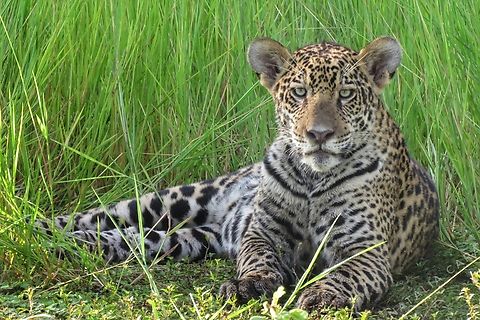
Naming
It comes to English from one of the Tupi–Guarani languages, presumably the Amazonian trade language Tupinambá, via Portuguese "jaguar". The Tupian word, "yaguara" "beast", is sometimes translated as "dog". The specific word for jaguar is "yaguareté", with the suffix -"eté" meaning "real" or "true".The first component of its taxonomic designation, "Panthera", is Latin, from the Greek word for leopard, "πάνθηρ", the type species for the genus. This has been said to derive from the "παν-" "all" and "θήρ" from "θηρευτής" "predator", meaning "predator of all", though this may be a folk etymology—it may instead be ultimately of Sanskrit origin, from "pundarikam", the Sanskrit word for "tiger".
"Onca" is the Portuguese "onça", with the cedilla dropped for typographical reasons, found in English as "ounce" for the Snow Leopard, "Uncia uncia". It derives from the Latin "lyncea" lynx, with the letter L confused with the definite article ".
In many Central and South American countries, the cat is referred to as "el tigre".
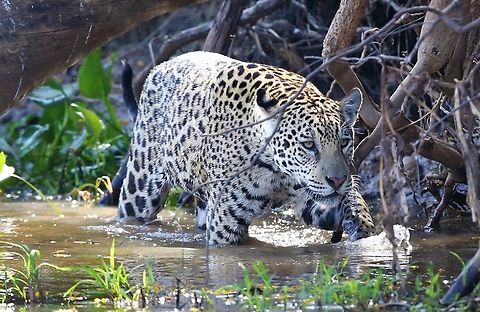
Distribution
Its present range extends from Mexico, through Central America and into South America, including much of Amazonian Brazil.The countries included in this range are Argentina, Belize, Bolivia, Brazil, Colombia, Costa Rica, Ecuador, French Guiana, Guatemala, Guyana, Honduras, Mexico, Nicaragua, Panama, Paraguay, Peru, Suriname, United States and Venezuela.
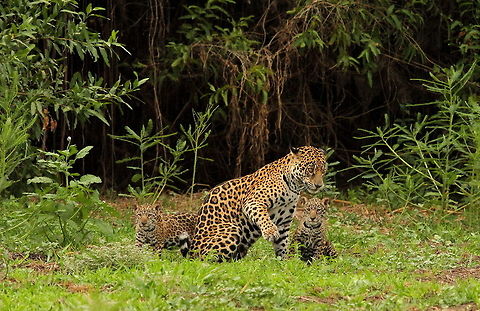
Status
Jaguar populations are rapidly declining. The animal is considered Near Threatened by the International Union for Conservation of Nature and Natural Resources, meaning it may be threatened with extinction in the near future.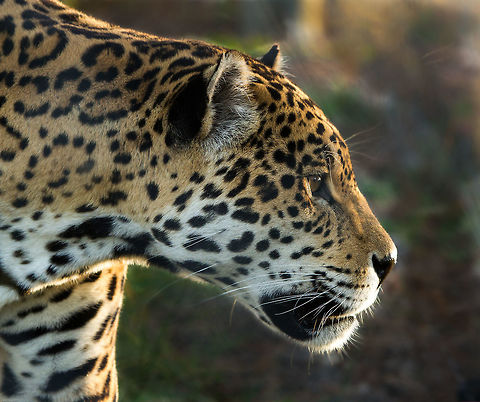
Behavior
Young males are at first nomadic, jostling with their older counterparts until they succeed in claiming a territory. Typical lifespan in the wild is estimated at around 12–15 years; in captivity, the jaguar lives up to 23 years, placing it among the longest-lived cats.Like most cats, the jaguar is solitary outside mother-cub groups. Adults generally meet only to court and mate and carve out large territories for themselves. Female territories, which range from 25 to 40 km2 in size, may overlap, but the animals generally avoid one another.
Male ranges cover roughly twice as much area, varying in size with the availability of game and space, and do not overlap. The jaguar uses scrape marks, urine, and faeces to mark its territory.
Like the other big cats, the jaguar is capable of roaring and does so to warn territorial and mating competitors away; intensive bouts of counter-calling between individuals have been observed in the wild.
Their roar often resembles a repetitive cough, and they may also vocalize mews and grunts. Mating fights between males occur, but are rare, and aggression avoidance behaviour has been observed in the wild. When it occurs, conflict is typically over territory: a male's range may encompass that of two or three females, and he will not tolerate intrusions by other adult males.
The jaguar is often described as nocturnal, but is more specifically crepuscular. Both sexes hunt, but males travel farther each day than females, befitting their larger territories. The jaguar may hunt during the day if game is available and is a relatively energetic feline, spending as much as 50–60% of its time active. The jaguar's elusive nature and the inaccessibility of much of its preferred habitat make it a difficult animal to sight, let alone study.
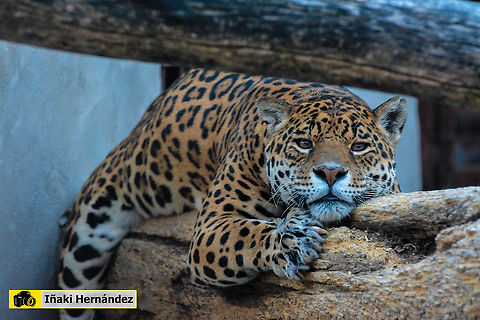
Habitat
The habitat of the cat includes the rain forests of South and Central America, open, seasonally flooded wetlands, and dry grassland terrain. Of these habitats, the jaguar much prefers dense forest; the cat has lost range most rapidly in regions of drier habitat, such as the Argentinian pampas, the arid grasslands of Mexico, and the southwestern United States.The cat will range across tropical, subtropical, and dry deciduous forests. The jaguar is strongly associated with water and it often prefers to live by rivers, swamps, and in dense rainforest with thick cover for stalking prey.
Jaguars have been found at elevations as high as 3,800 m, but they typically avoid montane forest and are not found in the high plateau of central Mexico or in the Andes.
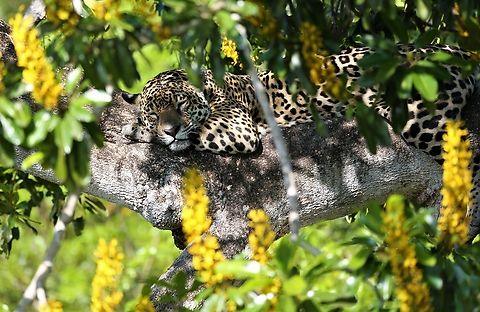
Reproduction
Jaguar females reach sexual maturity at about two years of age, and males at three or four.Mating pairs separate after the act, and females provide all parenting. The gestation period lasts 93–105 days; females give birth to up to four cubs, and most commonly to two. The mother will not tolerate the presence of males after the birth of cubs, given a risk of infanticide; this behaviour is also found in the tiger.
The young are born blind, gaining sight after two weeks. Cubs are weaned at three months but remain in the birth den for six months before leaving to accompany their mother on hunts. They will continue in their mother's company for one to two years before leaving to establish a territory for themselves.
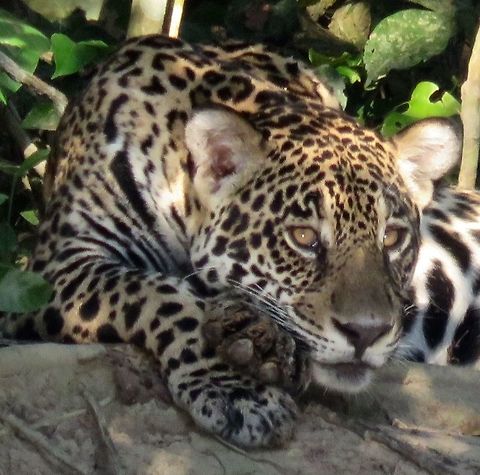
Food
Like all cats, the jaguar is an obligate carnivore, feeding only on meat. It is an opportunistic hunter and its diet encompasses 87 species.The jaguar prefers large prey and will take adult caiman, deer, capybara, tapirs, peccaries, dogs, foxes, and sometimes even anacondas.
However, the cat will eat any small species that can be caught, including frogs, mice, birds, fish, sloths, monkeys, and turtles. Some jaguars will also take domestic livestock, including adult cattle and horses.
While the jaguar employs the deep-throat bite-and-suffocation technique typical among "Panthera", it prefers a killing method unique amongst cats: it pierces directly through the temporal bones of the skull between the ears of prey with its canine teeth, piercing the brain.
This may be an adaptation to "cracking open" turtle shells; following the late Pleistocene extinctions, armoured reptiles such as turtles would have formed an abundant prey base for the jaguar. The skull bite is employed with mammals in particular; with reptiles such as caiman, the jaguar may leap on to the back of the prey and sever the cervical vertebrae, immobilizing the target.
While capable of cracking turtle shells, the jaguar may simply reach into the shell and scoop out the flesh. With prey such as smaller dogs, a paw swipe to the skull may be sufficient in killing it.
The jaguar is a stalk-and-ambush rather than a chase predator. The cat will walk slowly down forest paths, listening for and stalking prey before rushing or ambushing. The jaguar attacks from cover and usually from a target's blind spot with a quick pounce; the species' ambushing abilities are considered nearly peerless in the animal kingdom by both indigenous people and field researchers, and are probably a product of its role as an apex predator in several different environments.
The ambush may include leaping into water after prey, as a jaguar is quite capable of carrying a large kill while swimming; its strength is such that carcasses as large as a heifer can be hauled up a tree to avoid flood levels.
On killing prey, the jaguar will drag the carcass to a thicket or other secluded spot. It begins eating at the neck and chest, rather than the midsection. The heart and lungs are consumed, followed by the shoulders.
The daily food requirement of a 34 kilogram animal, at the extreme low end of the species' weight range, has been estimated at 1.4 kilograms. For captive animals in the 50–60 kilogram range, more than 2 kilograms of meat daily is recommended.
In the wild, consumption is naturally more erratic; wild cats expend considerable energy in the capture and kill of prey, and may consume up to 25 kilograms of meat at one feeding, followed by periods of famine.
Unlike all other species in the "Panthera" genus, jaguars very rarely attack humans. Most of the scant cases where jaguars turn to taking a human show that the animal is either old with damaged teeth or is wounded. Sometimes, if scared or threatened, jaguars in captivity may lash out at zookeepers.
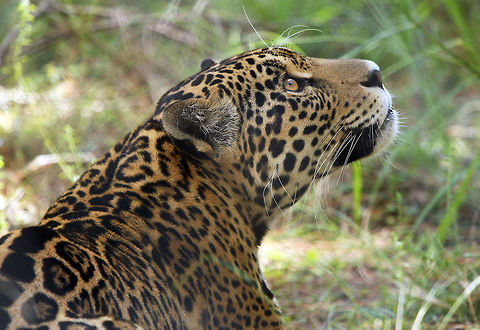
Cultural
The jaguar and its name are widely used as a symbol in contemporary culture. It is the national animal of Guyana, and is featured in its coat of arms. The flag of the Department of Amazonas, a Colombian department, features a black jaguar silhouette pouncing towards a hunter. The jaguar also appears in banknotes of Brazilian Real. The jaguar is also a common fixture in the mythology of many contemporary native cultures in South America, usually being portrayed as the creature which gave humans the power over fire.References:
Some text fragments are auto parsed from Wikipedia.